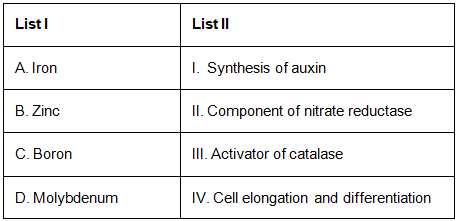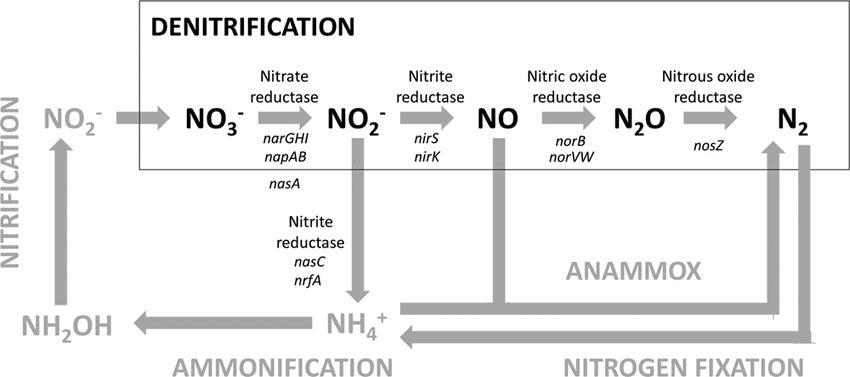NEET Previous Year Questions (2016-2025): Mineral Nutrition (Old NCERT) PDF Download
Q.1. Which micronutrient is required for splitting of water molecule during photosynthesis? [2023]
(a) Manganese
(b) Molybdenum
(c) Magnesium
(d) Copper
Ans. (a)
Solution.
- Manganese plays a major role in the splitting of water to liberate oxygen during photosynthesis.
- Copper is essential for the overall metabolism in plants.
- Molybdenum is included in nitrogen metabolism.
- Magnesium activates several enzymes involved in photosynthesis and respiration.
Q.2. Match List I with List II: [2023]

Choose the correct answer from the options given below:
(a) A-III, B-II, C-I, D-IV
(b) A-II, B-III, C-IV, D-I
(c) A-III, B-I, C-IV, D-II
(d) A-II, B-IV, C-I, D-III
Ans. (c)
Solution.
- Iron activates catalase enzyme.
- Zinc is needed in the synthesis of auxin.
- Boron is required for cell elongation and cell differentiation.
- Molybdenum is component of nitrogenase and nitrate reductase enzyme.
- Therefore, option (3) is correct.
Q.3. Which one of the following produces nitrogen fixing nodules on the roots of Alnus? [2022]
(a) Frankia
(b) Rhodospirillum
(c) Beijernickia
(d) Rhizobium
Ans. (a)
Solution. The most common association on roots is nodules. These nodules are small outgrowths on the roots. Frankia is a genus of nitrogen-fixing, free-living, filamentous bacteria. It produces nitrogen-fixing nodules on the roots of non-leguminous plants (e.g., Alnus). The species of rod-shaped Rhizobium forms nodules with the roots of several legumes and helps in nitrogen fixation.
Q.4. Match Column-I with Column- II. [2021]
Choose the correct answer from the options given below.
(a) (b) (c) (d)
(a) (iii) (i) (iv) (ii)
(b) (iv) (iii) (ii) (i)
(c) (ii) (iv) (i) (iii)
(d) (i) (ii) (iii) (iv)
Ans. (c)
Solution.
- Ammonia is first oxidised to nitrite by the bacteria Nitrosomonas and/or Nitrococcus.
- The nitrite is further oxidised to nitrate with the help of the bacterium Nitrobacter.
- Denitrification is carried by bacteria Pseudomonas and Thiobacillus.
- Both Rhizobium and Frankia are free-living in soil, but as symbionts, can fix atmospheric nitrogen.
Q.5. Match the following concerning essential elements and their functions in plants: [2020]
Select the correct option:
Ans. (a)
Solution:
Q.6. The product(s) of reaction catalyzed by nitrogenase in root nodules of leguminous plant is / are. [2020]
(a) Ammonia and oxygen
(b) Ammonia and hydrogen
(c) Ammonia alone
(d) Nitrate alone
Ans. (b)
Solution: Nitrogenase enzyme are responsible for the reduction of N2 to ammonia the product of reaction catalized by nitrogenase in root nodule of leguminous plants are ammonia and hydrogen
Q.7. A thiobacillus is a group of bacteria helpful in carrying out [2019]
(a) Denitrification
(b) Nitrogen fixation
(c) Chemoautotrophic fixation
(d) Nitrification
Ans. (a)
Solution: Denitrification is the process opposite to nitrogen fixation in which nitrates (NO-3) get converted into N2 gas by bacteria Pseudomonas denitrificans and Thiobacillus denitrificans.
In the process of denitrification, nitrates are reduced to gaseous compounds of nitrogen. Common bacteria causing denitrification of soil are Thiobacillus denitrificans, Pseudomous denitrificans, etc.
Q.8. Which of the following bacteria reduce nitrate in soil into nitrogen? [2019]
(a) Nitrobacter
(b) Nitrococcus
(c) Thiobacillus
(d) Nitrosomonas
Ans. (c)
Q.9. Which of the following elements is responsible for maintaining turgor in cells? [2018]
(a) Magnesium
(b) Sodium
(c) Potassium
(d) Calcium
Ans. (c)
Solution: Potassium helps in the maintenance of cell turgidity and opening and closing of stomata.
Q.10. In which of the following forms is iron absorbed by plants? [2018]
(a) Ferric
(b) Ferrous
(c) Free element
(d) Both ferric and ferrous
Ans. (a)
Solution: Iron is absorbed by plants in the form of ferric ions.
Q.11. Which is essential for the growth of root tip? [2016]
(a) Zn
(b) Fe
(c) Ca
(d) Mn
Ans. (c)
Solution: Calcium (Ca) is necessary for the proper growth and functioning of root tips and meristems.
Q.12. In which of the following all three are macronutrients? [2016]
(a) Molybdenum, magnesium, manganese
(b) Nitrogen, nickel, phosphorus
(c) Boron, zinc, manganese
(d) None of the above
Ans. (b)
Solution: From the given options, Option b has a better answer with macronutrients - Nitrogen, nickel and Phosphorus.
All other options have only micronutrients and thus 'b' turns the correct answer.
The primary macronutrients: nitrogen (N), phosphorus (P), potassium (K)
The three secondary macronutrients: calcium (Ca), sulfur (S), magnesium (Mg) the micronutrients/trace minerals: boron (B), chlorine (Cl), manganese (Mn), iron (Fe), zinc (Zn), copper (Cu), molybdenum (Mo), nickel (Ni).
In relatively large amounts, the soil supplies nitrogen, phosphorus, potassium, calcium, magnesium, and sulfur; these are often called the macronutrients. In relatively small amounts, the soil supplies iron, manganese, boron, molybdenum, copper, zinc, chlorine, and cobalt, the so-called micronutrients. Nutrients must be available not only in sufficient amounts but also in appropriate ratios. So, the correct answer is option b.
Q.13. In which of the following, all three are macronutrients? [2016]
(a) Boron, zinc, manganese
(b) Iron, copper, molybdenum
(c) Molybdenum, magnesium, manganese
(d) Nitrogen, nickel, phosphorus
Ans. (a)
Solution: (Bonus) Nitrogen, phosphorus, potassium, calcium, sulfur and magnesium are the macronutrients. In the above given options no three-element denotes macronutrients.
Q.14. Minerals known to be required in large amounts for plant growth include: [2015]
(a) Calcium, magnesium, manganese, copper
(b) Potassium, phosphorus, selenium, boron
(c) Magnesium, sulphur, iron, zinc
(d) Phosphorus, potassium, sulphur, calcium
Ans. (d)
Solution: Phosphorus, potassium, sulphur and calcium play an important role in plants growth. These minerals are required in large amount.
Phosphorus is required for all phosphorylation reactions and constitution of cell membrane, nucleic acids and some proteins.
Potassium is related to protein synthesis, closing and opening of stomata and activation of enzyme.
Calcium regulates metabolic activities, function of cell membrane and stabilizes the structure of chromosomes.
Sulphur is the main constituent of the amino acids, cystine and methionine, coenzymes and vitamins.
Q.15. Which one gives the most valid and recent explanation for stomatal movements? [2015]
(a) Potassium influx and efflux
(b) Starch hydrolysis
(c) Guard cell photosynthesis
(d) Transpiration
Ans. (a)
Solution: The opening and closing of stomata are caused by the influx and efflux of potassium ions (K+). The increase of K+ results in opening of stoma and decrease of K+ causes closing of stoma. The turgidity of guard cells induces to open the pores of stomata found on the surface of leaves.
Q.16. Deficiency symptoms of nitrogen and potassium are visible first in: [2014]
(a) Senescent leaves
(b) Young leaves
(c) Roots
(d) Buds
Ans. (a)
Solution: The parts of the plants that show the deficiency symptoms also depend on the mobility of the element in the plant. For elements that are actively mobilised within the plants and exported to young developing tissues, the deficiency symptoms tend to appear first in the older tissues.
For example, nitrogen, potassium and magnesium are visible first in the senescent leaves.















